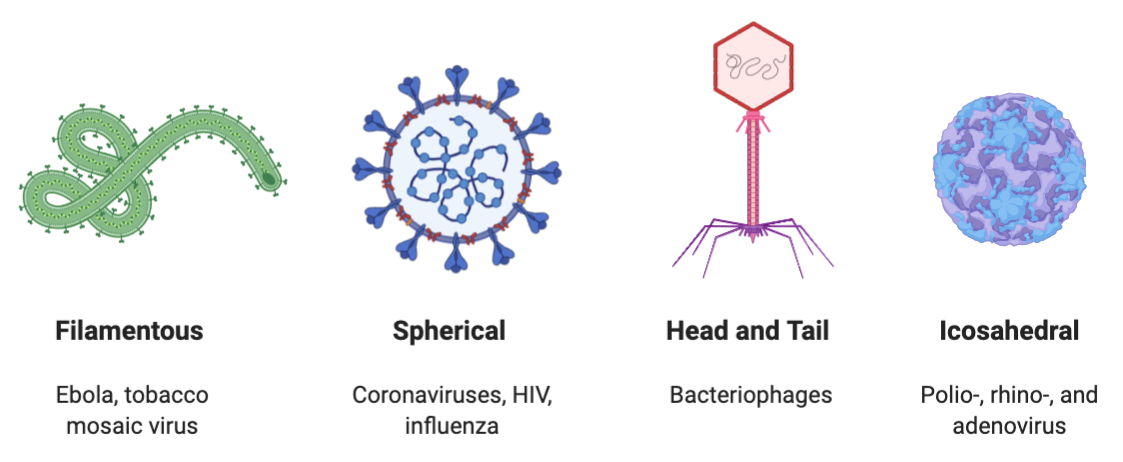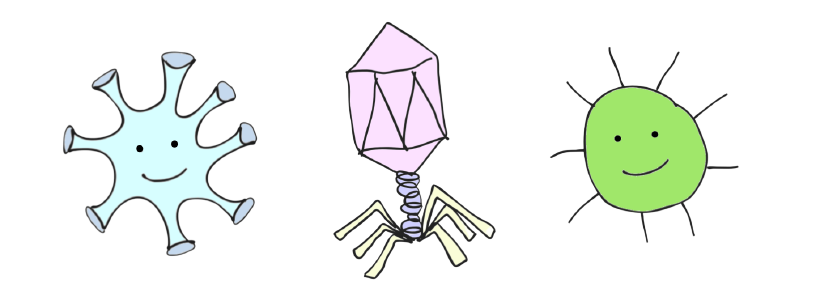Viruses in the Environment
When we think of viruses today, we imagine tiny disease-causing invaders. The COVID-19 pandemic has brought viruses to the forefront of people’s minds, and we are constantly looking for ways to avoid, kill, and fight off viruses. Many well-known viruses do cause diseases in animals and plants, but a far greater number of viruses are necessary for the survival of cellular life, either for an individual species or an entire ecosystem. Viruses help maintain the health of the oceans, and still others can help our immune systems develop.
The Human Virome
You may be familiar with the microbiome, a collection of single-celled organisms that live in and on animal bodies. These microbes digest food, out-compete harmful invaders, assist in organ development, and much more. Animals also have a virome, a collection of non-pathogenic viruses that live in cooperation with the hosts. In the gut, these viruses are predominantly bacteriophages, or phages for short. Their name indicates that they kill bacteria. One of their primary functions is to keep our microbial populations in check so that they do not overrun our bodies. They also look quite different from the viruses we are used to hearing about today, such as SARS-CoV-2, influenza, HIV, Ebola, and polio viruses. In the diagram below, you can see the most common virus shapes.

Filamentous viruses are long and thread-like. Icosahedral viruses may look spherical at first glance, but their capsids are made of 20 triangular faces. Unlike icosahedral viruses, spherical viruses are enclosed by a lipid envelope, which gives them their spherical shape. Bacteriophages resemble spaceships with a capsid head connected by a long tail. The tail ends in fibers that allow the phage to land on and attach to bacterial hosts.
Studies of the human virome have only recently taken off, so the field is still dealing with issues such as cataloging the viral species and genes found in humans. Since viruses are so much smaller than bacterial and human cells, the techniques used to filter out cellular matter will often remove much of the viral genetic material. Other methods sequence all the genes present in a sample and then separate them into human, bacterial, and viral clusters 1. However, since virome studies are still in their infancy, there is no database that comes close to meeting scientists’ needs, so you find a lot of viral dark matter -- viruses that we know are there, but can’t identify because they don’t match anything that we already know 2.
Gut microbes (bacteria) have been implicated in diseases such as inflammatory bowel disease, diabetes, obesity, malnutrition, and allergies. It is likely that since the virome and microbiome are so intricately linked, the gut virome also contributes to human diseases. However, we have not yet figured out which bacterial species are problematic for certain conditions because the gut microbiome is a collection of many species, and only small-scale studies have been conducted so far. The gut microbiome is an ecosystem itself, just like forests, oceans, deserts, and lakes are all ecosystems that support many organisms interacting with each other. Similarly, since the virome is not yet well-catalogued, it will be a while before scientists can pin down an individual virus as the root cause of a disease as complicated as obesity.
Besides viruses floating around in our tissues, there are viruses in our very genomes. Viruses that make DNA can sometimes leave behind viral “fossils,” bits of DNA integrated into host cells that serve as records of past infections. If these bits of DNA make it into germ cells, the cells that give rise to eggs and sperm, and are passed down through generations, they become endogenous viral elements (EVEs). In humans, EVEs typically come from retroviruses, but some originate in other types of viruses. Retroviruses are a subset of RNA viruses that REQUIRE genome integration as part of their replication cycle. The only human retroviruses are HIV and human T-lymphotropic viruses. Hepatitis B virus is a DNA virus that also has reverse transcription ability and behaves somewhat like retroviruses.
Endogenous viral elements are usually nonfunctional pieces of DNA that were previously considered to be “junk DNA.” They may be full viral genomes or only fragments, which affects how they behave in human cells. EVEs make up around 5-8% of the entire human genome, and most of them were probably acquired early in human evolution 3. Since they do not confer an evolutionary advantage on humans, they are often lost or degraded within a few generations.
Animal Viromes
Viromes are not just restricted to humans. A variety of viruses live symbiotically with other animals, often performing even more astounding feats than the viruses of humans. For example, polydnaviruses are domesticated viruses because their replication and functions are completely directed by wasps of the braconid family, which house the viruses. These wasps prey on the larvae of beetles, flies, moths, and butterflies. In the ovaries of female wasps, the bracovirus is replicated and packaged into eggs. The females then lay their eggs inside insect larvae, which are used as living incubators. Some of the viral genes suppress the larva’s immune system, paralyzing it and preventing it from entering the next stage, called the pupa, when it transforms into an adult insect. When the wasp eggs hatch, the baby wasps can eat the host insect from within and mature.
The bracovirus genome is actually integrated into the wasp genome. The virus has a two-phase life cycle. In the vegetative state, it is simply replicated along with the wasp genome whenever a wasp cell divides. In this way, it is no different from any other wasp gene. However, in a female wasp’s ovaries, the DNA of this virus is copied and circularized into a viral genome. Viral envelopes and nucleocapsids are made, and the fully formed viruses are released into the oviduct. However, the wasp can control the genes that are packaged into the virus particles. The genes that produce structural proteins to build new viruses are not included, so the virus cannot replicate in the larval hosts 4.
Endogenous viral elements (EVE) in other animals, particularly insects, seem to be functional and are therefore retained in the genome. Polydnaviruses are a type of EVE because they are integrated into wasp genomes. Other insect EVEs do not make functional viruses, but may instead be able to help arthropods clear viral infections 5.
Viruses in the Oceans
Although we do not have much knowledge of the specific roles of viruses in human health, we have a better understanding of how viruses maintain the integrity of the oceans by regulating the flow of organic matter. In fact, the first studies of viruses took place in the oceans, and we have only recently begun studying the beneficial effects of viruses in terrestrial organisms.
Viruses are found in every aquatic environment. Using more sensitive instrumentation in the last several decades, viruses have been detected in coral reefs, sediments, the deep ocean, and freshwater. Although some marine viruses are pathogenic, such as piscine viruses that cause headaches for aquaculture farmers, the vast majority are not. 6
Viruses are necessary to keep bacterial and algal populations in check. To ecologists, the concept of a “dead zone” has become all too common in recent years. Agricultural run-off, which contains nitrates and phosphates, can get into waterways and stimulate overgrowth of photosynthetic bacteria (a.k.a. cyanobacteria), which in turn depletes oxygen and hinders the growth of other organisms. Viruses can reduce bacterial and algal overgrowth, which allows room for other organisms to thrive. Diverse ecosystems are always healthier ecosystems. In fact, scientists have been exploring the use of cyanophages -- viruses (phages) that kill cyanobacteria -- to prevent this eutrophication caused by increased agricultural activity. This could help reduce the area of the dead zones located where the Mississippi River flows into the Gulf of Mexico and fertilizers and pesticides accumulate.
By killing these unicellular organisms, viruses also maintain the “circle of life” by recycling nutrients. This recycling is part of a process known as the viral shunt. When viruses kill certain microorganisms, they free up organic carbon to be taken up by other microbes. This prevents any single species from dominating an ecosystem and maintains diversity. In this way, viruses shunt carbon between organisms in the same level of the food web, kind of like decomposers. 7
Viruses drive evolution of hosts by selecting for host organisms with resistance mechanisms. This in turn exerts a selective pressure on viruses to evade these mechanisms, furthering the evolutionary arms race. Phages can also transfer genes between microorganisms through transduction, the process by which they insert their genetic material into bacteria 8. It is hypothesized that many metabolic genes originated in viruses and have helped to diversify how unicellular organisms in the ocean acquire energy.
Conclusion
Viruses are some of the least studied biological entities on Earth They are most often studied in the context of infection and disease, so until recently, their roles in maintaining large and small ecosystems have been largely overlooked. As I discussed in my previous post, viruses aren’t considered to be alive, but they are still important parts of biological cycles. With more detection and analysis, we will learn more about the vast array of undiscovered viruses in our world and come to understand them better as key members of the Earth's ecosystems.

Leave a Comment